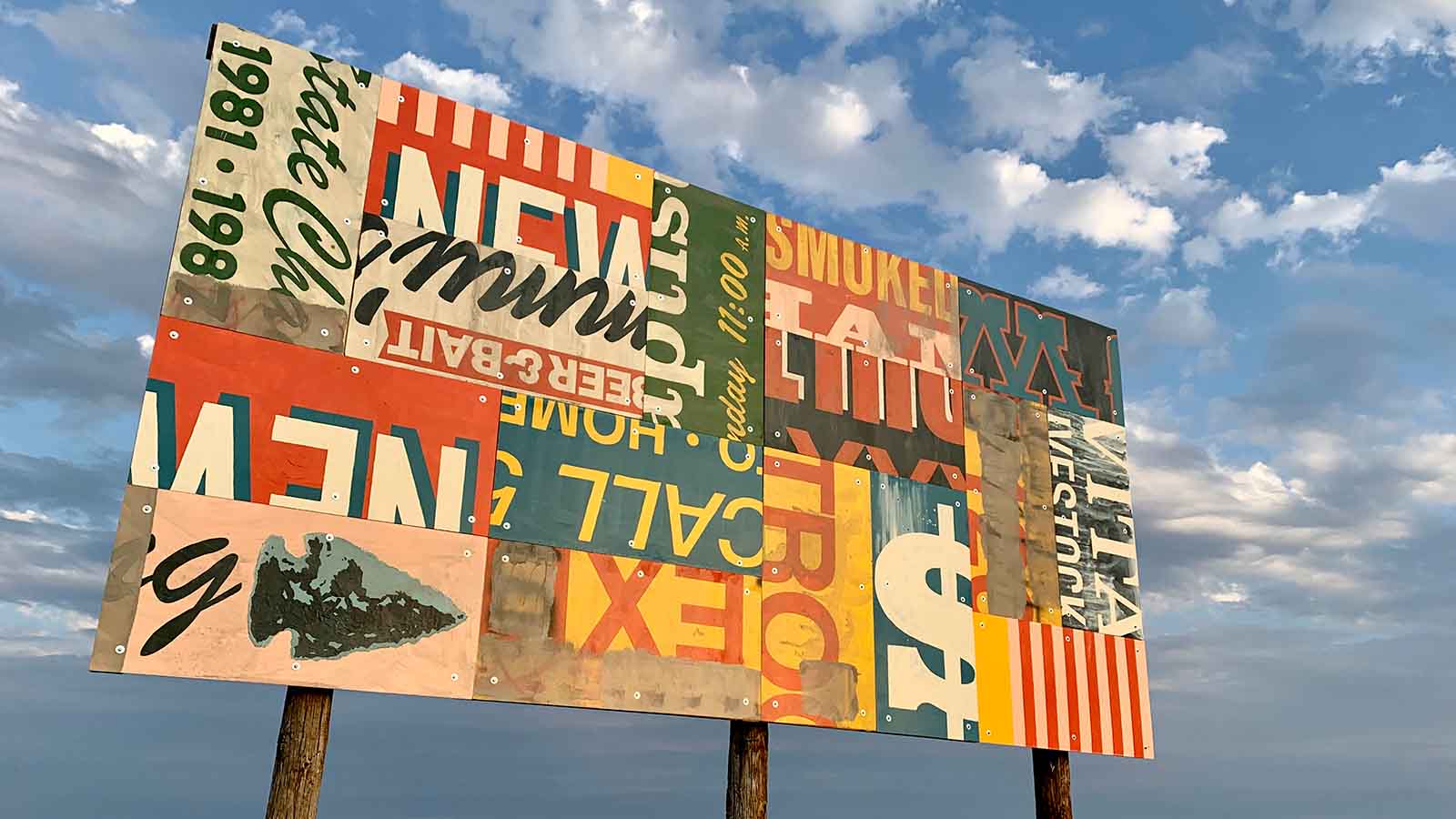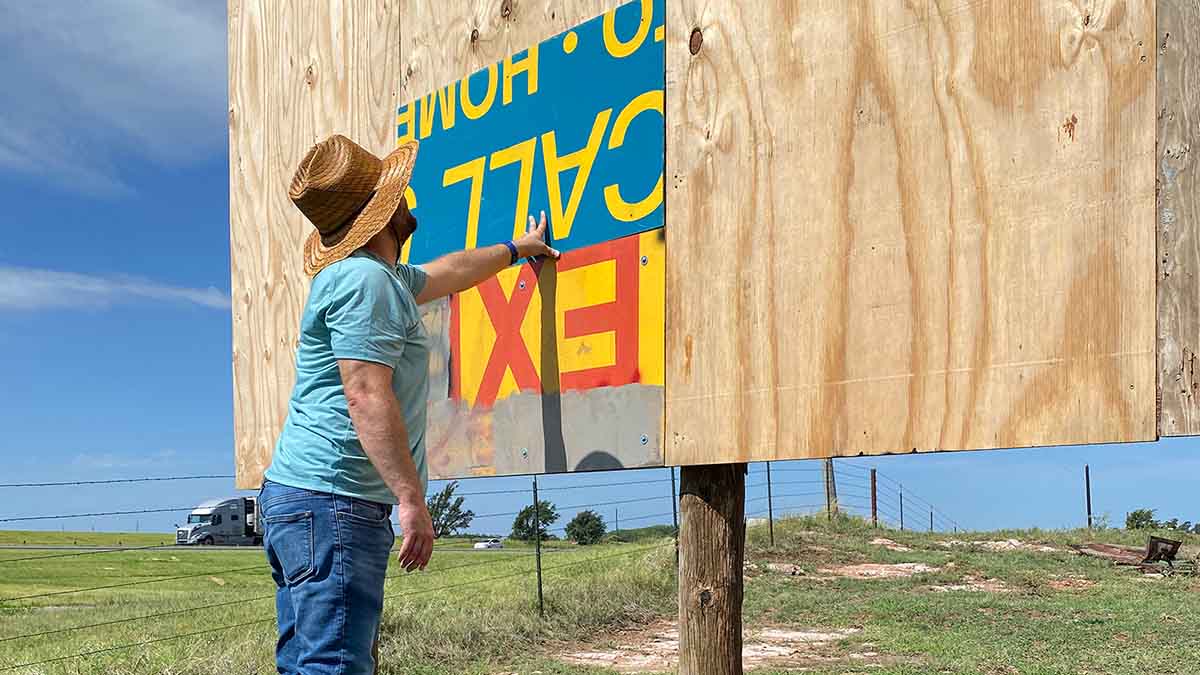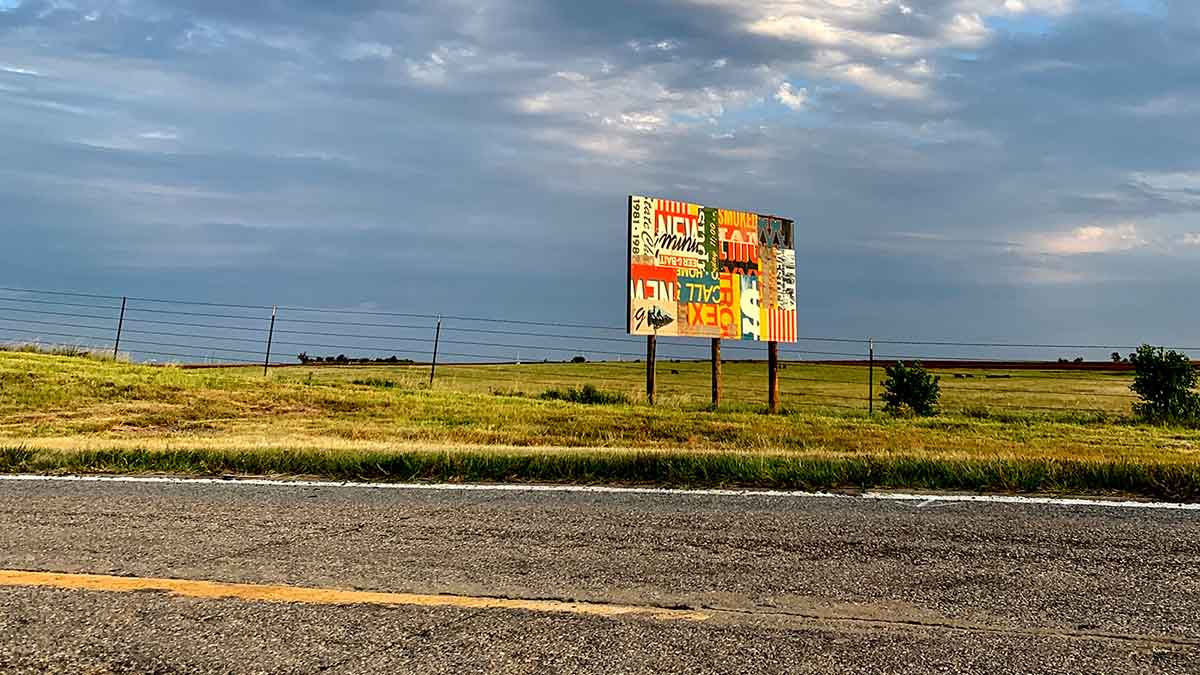Fuller Creates “Signs” Art Installation on Route 66
November 15, 2021
Corey Fuller is an artist, with creativity and imagination running through every aspect of his life. While he fulfills his calling to teach others in his roles at OBU as the chair of Art and Design, Ruth Jay Odom Professor of Fine Arts and professor of graphic design, Fuller also practices what he teaches as a working artist and designer. As part of his creative expression outside of the classroom, he recently completed a major project – an art installation titled “Signs” on a billboard along Route 66 in western Oklahoma.
The project, which began last fall, consists of 16 individual hand painted signs, measuring two feet by four feet each, on Masonite and plywood. The panels are mounted to a billboard measuring 16 feet by 8 feet that was constructed on-site. The signs each refer to fictional places or things.
“The difference between this and an actual commercial billboard is, of course, that real billboards refer to real places and things,” Fuller said. “In this case, my billboard refers only to a fictionalized reality. However, of course, the billboard is in fact real.”
According to the “Signs” page on Fuller’s website, the work is intended to challenge the traditional understanding of a “sign.”
Fuller writes, “In the study of semiotics, we discover that a sign is comprised of the signifier and the signified. For instance, in our culture, a red octagon (the signifier) represents the idea of coming to a stop (the signified). The Swiss linguist Ferdinand de Saussure, the founder of semiotics or semiology, taught that the signifier itself is arbitrary. For instance, a red octagon could have just as easily meant go, which obviously would now create some traffic problems.”
In the case of the art installation, though, the signifier points to a nonexistent signified object or action. Although the referents in Fuller’s signs do not actually exist, the ‘sign’ persists in the physical space. Essentially the signs are somewhere but point to nowhere, other than in the imagination.
Fuller commented on his sources of inspiration for this project.
“I’ve always been interested in billboards which I think stems from traveling so much as a kid, road-tripping with the family through barren landscapes like west Texas and New Mexico,” he said. “There were no smartphones or iPads, so we just took in the world around us, the car window being my window to the world. Even as a young kid, I was always taking notice of the typefaces and color schemes of roadside signage.”
In particular, though, Fuller said he visually enjoys billboards that are a collage of different signs.
“Those pieces of reclaimed wood from old chopped-up signs create a palimpsest of sorts. The unintentional, haphazard croppings create new meanings. They have an unintentional deconstructivist aesthetic,” Fuller said.
Heavily influenced by Oklahoma-born artist Ed Ruscha, Fuller said he gravitates towards the ideas of isolation and decay in his work and also blurring the lines between graphic design and fine art. This influence played a large part in motivating Fuller to start and complete this project.
“I decided to create a billboard from the ground up and install my own panels or signs on it with the idea being that the artwork would become naturally weathered and distressed over time,” he said. “With a lot of help from my brother-in-law, we dug holes, set the poles and poured 2400 pounds of concrete to create the structure, not to mention adding some really overpriced plywood.”
Fuller plans to eventually remove and sell the individual panels as individual art pieces. He then plans to rotate in some new work, either all at once or individually and slowly over time.
“The billboard structure essentially is the canvas for the work,” he said. “I plan to take pictures of the installation throughout the seasons to capture its slow evolution.”
Fuller then explained that the events and products advertised in the signs, while not unbelievable, are indeed fictitious.
“Among the signs, viewers will see references to a livestock auction, football championships and smoked ham — all of which aren’t inconceivable referents but are indeed works of a visual, fictional narrative,” he said.
The same pattern of fiction blending into reality goes for the installation as a whole.
“Even though the sign stands in contrast to its surroundings—western Oklahoma farmland—it is camouflaged in a sense, in that it was created to blend in and not appear drastically different from other billboards that might be in the area.”
For those planning to visit the installation, Fuller said it’s best viewed while driving west on Route 66 between Weatherford and Clinton. The sign may also be viewed from westbound I-40 between mile markers 77 and 76 on the north side of the interstate.
“If you visit, be sure to take a picture or selfie and use the hashtag #TheSignOn66,” Fuller said.
Fuller has exhibited his work in many venues, including Space 38|39, New York City, Indiana Wesleyan University, University of Central Oklahoma and more. He is a professional member, former guest-speaker, vice president and member of the educational board for the American Institute of Graphic Artists of Oklahoma. He is also involved with Tulsa Art Director’s Club and the International Arts Movement, NYC.
Fuller's design work has earned several Gold Addy Awards and recognition from the American Marketing Association. His present and past students have also won multiple Addy Awards in both the student and professional categories. In 2013, Fuller was honored with OBU’s Promising Teacher award.
Learn more about Corey Fuller and his work.
Learn more about Art and Design at OBU.


